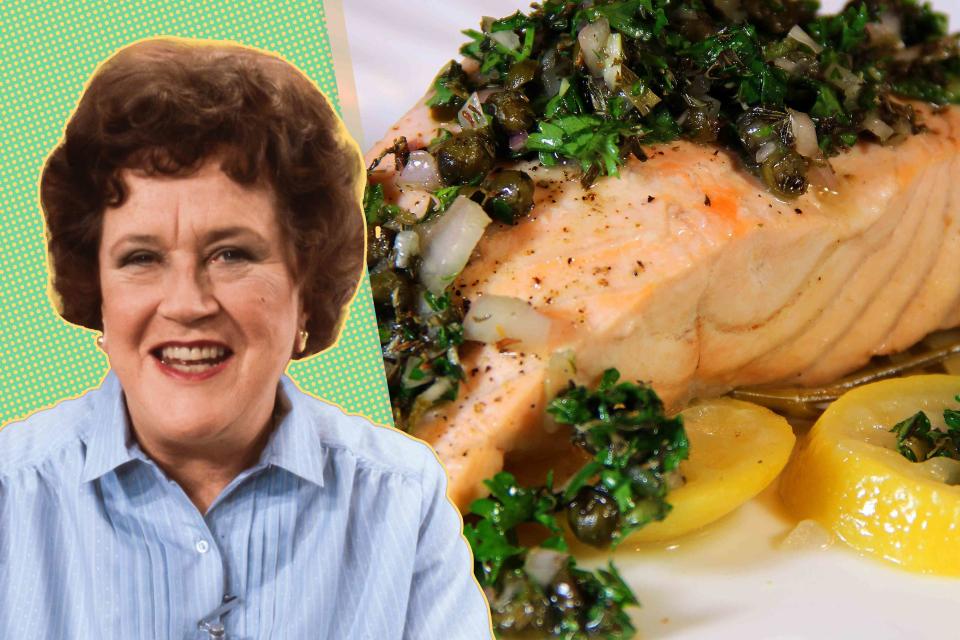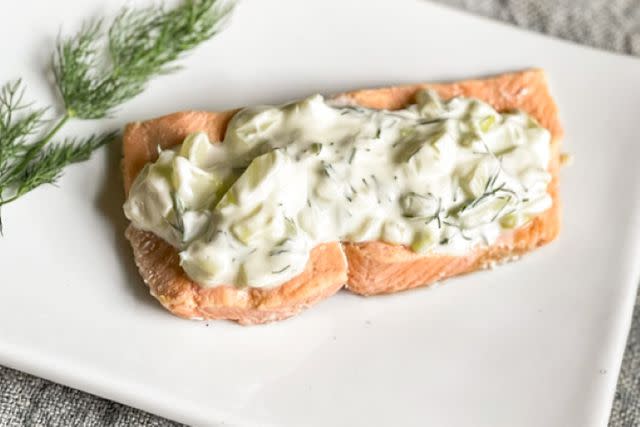The Julia Child Salmon Recipe I’ve Been Making for 25 Years (It's Foolproof)
It results in perfectly cooked fish every single time.

Simply Recipes / Photo Illustration by Wanda Abraham / Getty Images
When I was growing my private chef business in the early 2000s, salmon was the protein of the moment. Everyone was talking about Omega-3’s and heart health, and a famous doctor was on all the talk shows touting it as a weight loss food that kept your skin taut and glowing. My clients were clamoring for salmon dishes—one couple wanted to eat it almost every night.
Luckily, Julia Child’s cookbook, The Way To Cook, was on my bookshelf, and it provided me with a foolproof cooking method that produced moist, perfect salmon every time. Her Master Fish Poaching recipe, along with her Poached Salmon with Cucumber Sauce recipe, has been saving the day ever since.
What I Love About Julia Child’s Salmon Recipe
Julia’s poaching method is best in part because you can stay close and monitor those precious filets in a way that you can’t when they are in the oven. It’s ideal for making cooked salmon for other recipes, as I did for my clients. Once you have perfectly poached salmon, you can use it in salads, pasta, sandwiches, and whatever else you can dream up. It’s a foolproof meal prep item, especially in the summer.

Simply Recipes / Robin Asbell
The Master Fish Poaching Recipe
Fill a deep, wide pan with three inches of water. It seems like a lot, but you must maintain the temperature once you add the salmon.
Add 1 1/2 teaspoon salt and three tablespoons white wine vinegar. Bring to a boil, then reduce to medium.
Slip up to 8 (1/2- inch-thick) salmon fillets, bones removed and skinned, if you prefer, into the water and maintain a very gentle simmer, lowering the heat to keep the water from bubbling vigorously. It’s better to poach too slowly than too quickly.
Set a timer for six minutes and hover close with your thermometer, testing the fish frequently until it hits 140°F to 145°F as it may be cooked through before the timer goes off (more on that below). Other kinds of fish can be poached the same way, just adjust the time for the size of the filets. Julia recommends two to three minutes for sole, for example. Use a fish spatula or slotted spatula to carefully lift the filets out and blot them with a clean kitchen towel.
For the cucumber sauce:
Prep this sauce before poaching the fish—it makes plenty for eight fillets.
1 cucumber, peeled, seeded, and finely chopped
1/4 teaspoon each salt, sugar, and white wine vinegar
2 tablespoons fresh dill leaves, coarsely chopped
1 cup sour cream, or half sour cream and half yogurt
Stir together all ingredients in a medium bowl and reserve.
The fish can be served warm or cold, with the sauce spooned on top. The poached fish can also be cooled and broken into pieces to use in other dishes and can be kept in the refrigerator for three days, tightly covered.
Whether you poach salmon to serve with this simple, classic cucumber sauce or to toss into a quick pasta, you’ll have moist, rich salmon every time.

Simply Recipes / Robin Asbell
My Tip for This Recipe
One tip I would add is that the timing of the poach is often shorter for me than it is in the original recipe. I generally cook wild-caught salmon, which I learned very quickly takes less time than fattier farm-raised salmon, and I often buy less expensive, thinner tail pieces.
So, instead of relying strictly on a timer, I get out my instant-read thermometer (you have one, right?) and start testing as soon as I see some fine white lines starting to pop out of the flesh, going for 140°F to keep the center of the flesh succulent or 145°F for firm salmon.
Read the original article on Simply Recipes.


